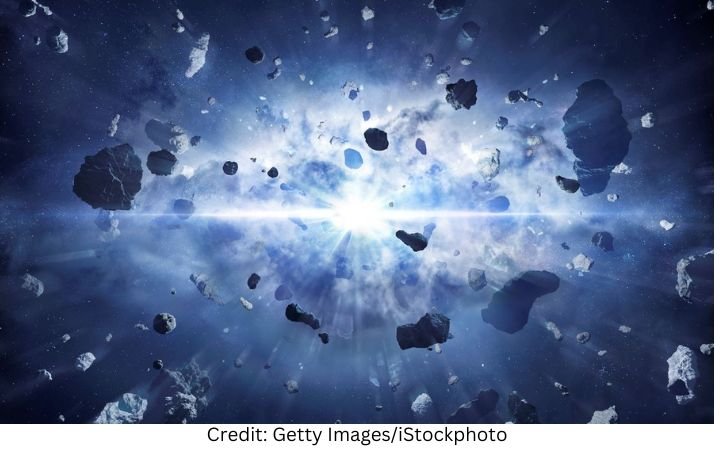The Big Bang Theory: The Most Widely Accepted Scientific Explanation for the Universe’s Origins
The Big Bang Theory is the most widely accepted scientific explanation for the origins of our universe. According to this theory, the universe began as a single, infinitely hot and dense point around 13.7 billion years ago. This point underwent a massive expansion, creating space and matter, and setting in motion the growth of our cosmos.
Cosmic Inflation: The Rapid Expansion of the Universe
Initially, this expansion happened at a speed far exceeding light, known as the period of “cosmic inflation,” lasting only a tiny fraction of a second. Afterward, expansion continued at a slower rate, leading to the formation of galaxies, stars, planets, and everything we observe today. Although scientists cannot directly observe the universe’s beginning, they can gather evidence through mathematical models and physical phenomena.
Evidence Supporting the Big Bang Theory
A significant piece of evidence supporting the Big Bang Theory is the cosmic microwave background (CMB) — an “echo” of the initial explosion, visible as faint radiation left over from the early universe. First predicted in 1948, the CMB was detected in 1965 by accident when Arno Penzias and Robert Wilson, two scientists at Bell Laboratories, discovered a persistent noise in their radio receiver. This noise turned out to be the faint radiation from the Big Bang, a groundbreaking confirmation for the theory.
Alternative Theories and Why the Big Bang Remains Dominant
Despite its widespread acceptance, the Big Bang Theory has sparked alternative explanations for the universe’s origin, such as eternal inflation or an oscillating universe that cycles between expansion and contraction. Nevertheless, the theory remains the most widely supported model because it aligns closely with observable evidence, including three major findings.
- Hubble’s Law: This law shows that distant galaxies are moving away from us at a speed proportional to their distance, indicating a uniformly expanding universe.
- Cosmic Microwave Background: A cosmos that began hot and dense and cooled as it expanded is consistent with the CMB’s characteristics.
- Element Abundance: The observed abundances of light elements such as helium, lithium, and deuterium match what would be expected from nuclear reactions during the early minutes of the universe’s formation.
Evolution of the Big Bang Theory
The theory itself has evolved, as scientists have adjusted and added concepts to explain observed phenomena better. For instance, cosmic inflation was introduced in 1980 by physicist Alan Guth to address some challenges in the Big Bang model, like the universe’s uniform temperature. This rapid expansion period helps explain why the temperature of the CMB is consistent across vast distances. Without this inflationary phase, different parts of the universe would have been too far apart to interact, leaving them with vastly different temperatures.
Formation of Fundamental Particles and the “First Light”
After inflation ended, the universe continued expanding and cooling, allowing the formation of fundamental particles like neutrons, electrons, and protons within the first second. At this time, the temperature was still extremely high — about 10 billion degrees Fahrenheit (5.5 billion Celsius), according to NASA. These particles eventually combined to form atoms, allowing light to pass freely through space for the first time, roughly 380,000 years after the Big Bang. This “first light” is what we now see as the CMB, providing a snapshot of the universe as it looked in its early stages.
Gravitational Waves and Their Significance
In addition to light elements, gravitational waves — tiny ripples in space-time caused by significant events like colliding black holes or the birth of the universe — also offer clues. These waves, first theorized by Albert Einstein, were detected in 2016 by the Laser Interferometer Gravitational-Wave Observatory (LIGO), marking a significant milestone in understanding cosmic inflation. However, attempts to find “B-modes,” a specific pattern of polarization in the CMB thought to be linked to inflation, faced challenges. In 2014, researchers initially claimed to have detected B-modes but later found that the signal was likely due to galactic dust rather than evidence of inflation.
Mapping the Cosmic Microwave Background
Observations of the CMB have played a crucial role in refining our understanding of the universe’s age. NASA’s Cosmic Background Explorer (COBE) and later missions, including the Wilkinson Microwave Anisotropy Probe (WMAP) and the European Space Agency’s Planck satellite, mapped this radiation in increasing detail. The Planck satellite’s data, released in 2013, calculated the universe’s age more precisely as 13.82 billion years.
Mysteries of Dark Matter, Dark Energy, and the Multiverse
Beyond confirming the Big Bang, CMB maps have revealed new mysteries, like why the Southern Hemisphere of the CMB appears slightly warmer than the Northern Hemisphere, despite predictions that it should look uniform. These observations have also shown that only about 5% of the universe consists of ordinary matter like stars and planets. The remainder is thought to be composed of dark matter and dark energy, two mysterious substances that cannot be directly observed but exert significant influence on the universe’s structure and expansion.
Scientists have also speculated that our universe may be part of a “multiverse” — a vast collection of different universes. According to this theory, the rapid inflation that occurred at the universe’s inception could have led to the creation of separate regions, each forming a unique universe with potentially different physical laws. MIT physicist Alan Guth, a key figure in developing inflation theory, has noted that most inflation models imply a multiverse, making it a topic of increasing scientific interest.
Advancements in Observing the Universe: Hubble and James Webb Space Telescopes
Astronomers use advanced technology to explore the universe. While the Hubble Space Telescope has provided views of galaxies as they appeared billions of years ago, its successor, the James Webb Space Telescope (JWST), launched by NASA in 2021, can look even further back. With its infrared capabilities, JWST can observe extremely distant galaxies whose light has shifted from visible to infrared wavelengths as the universe expands. JWST’s mission includes searching for the earliest galaxies and stars, offering a deeper understanding of the universe’s infancy.
The Big Bang Theory in Popular Culture
The term “Big Bang Theory” became familiar not only to scientists but also to the public, especially after the popular comedy TV show of the same name aired from 2007 to 2019. This show, The Big Bang Theory, follows a group of scientists and popularized the term while bringing science into everyday conversation. Although the show primarily focused on humor and character dynamics rather than in-depth science, it employed a science consultant, UCLA astrophysicist David Saltzberg, who ensured that scientific concepts discussed or written on whiteboards were accurate.
In one memorable episode, characters on the show embark on a research expedition to the Arctic, a location chosen for many real-life physics experiments due to its stable conditions for certain observations. The show also featured aerospace engineer Howard Wolowitz taking a fictional trip to space on a Russian Soyuz spacecraft, a nod to real scientific expeditions and collaborations in space exploration.
The Ongoing Exploration of Our Universe’s Origins
The Big Bang Theory, both as a scientific model and a pop culture phenomenon, has shaped our understanding of the universe and expanded public awareness of astrophysics. Though our knowledge of the universe’s origins is incomplete, advances in observational technology and theoretical physics bring us closer to unraveling the mysteries of how everything began. Whether through CMB observations, gravitational wave detections, or theoretical frameworks like inflation and multiverse models, our exploration of the universe continues, uncovering both answers and new questions about the cosmos.










